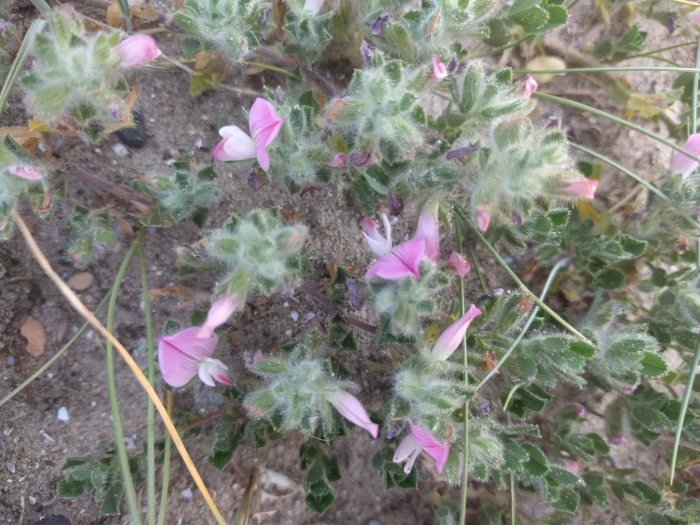Spiny Restharrow
(Ononis spinosa)
Spiny Restharrow (Ononis spinosa)
/
/

Michel Langeveld
CC BY 4.0
Image By:
Michel Langeveld
Recorded By:
Copyright:
CC BY 4.0
Copyright Notice:
Photo by: Michel Langeveld | License Type: CC BY 4.0 | License URL: http://creativecommons.org/licenses/by/4.0/ | Rights Holder: Michel Langeveld | Publisher: iNaturalist | Date Created: 2020-06-26T16:34:21-07:00 |


















Estimated Native Range
Summary
Ononis spinosa, commonly known as Spiny Restharrow, is a perennial herb native to a wide range of habitats across Europe, including Britain, but is notably scarce in Scotland. It is adapted to open, sunny environments such as grasslands, coastal dunes, and open woodlands, particularly favoring calcareous soils. This plant typically grows up to 18 inches tall and is characterized by its wiry, spiny stems that make it difficult to handle. The leaves are dark green, oval to trefoil in shape, and the plant produces deep pink to white pea-like flowers from late spring to late summer, which are moderately showy and attract pollinators.
Spiny Restharrow is valued for its drought tolerance and ability to thrive in poor, lime-rich soils, making it suitable for xeriscaping and naturalistic plantings. It is also used in traditional medicine, particularly in Russia, for its diuretic and anti-inflammatory properties. In cultivation, it requires full sun exposure and well-drained soil, and once established, it has low water requirements. While not commonly used in ornamental horticulture, it can be utilized in wildflower meadows or as part of a mixed border in gardens that aim to support native biodiversity. Care should be taken as it can become invasive in some conditions and may spread beyond its intended area.CC BY-SA 4.0
Spiny Restharrow is valued for its drought tolerance and ability to thrive in poor, lime-rich soils, making it suitable for xeriscaping and naturalistic plantings. It is also used in traditional medicine, particularly in Russia, for its diuretic and anti-inflammatory properties. In cultivation, it requires full sun exposure and well-drained soil, and once established, it has low water requirements. While not commonly used in ornamental horticulture, it can be utilized in wildflower meadows or as part of a mixed border in gardens that aim to support native biodiversity. Care should be taken as it can become invasive in some conditions and may spread beyond its intended area.CC BY-SA 4.0
Plant Description
- Plant Type: Shrub
- Height: 0.5-1.5 feet
- Width: 1.5-2 feet
- Growth Rate: Slow
- Flower Color: Pink
- Flowering Season: Summer
- Leaf Retention: Deciduous
Growth Requirements
- Sun: Full Sun, Part Shade
- Water: Low, Medium
- Drainage: Medium
Common Uses
Drought Tolerant, Low Maintenance, Rabbit Resistant
Natural Habitat
Open, sunny environments such as grasslands, coastal dunes, and open woodlands, particularly on calcareous soils
Other Names
Common Names: Restharrow, Thorny Restharrow
Scientific Names: , Ononis spinosa, Anonis spinosa, Bonaga spinosa, Ononis antiquorum subsp. maritima, Ononis arvensis subsp. spinosiformis, Ononis spinescens, Ononis spinosa var. latifolia, Ononis spinosa var. nitis, Ononis spinosiformis,
GBIF Accepted Name: